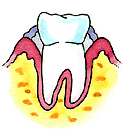
Periodontal Gum Surgery
Gum surgery, or periodontal disease surgery, involves a group of several surgical dental treatments generally performed by a periodontist to treat conditions affecting the gums, the connective tissues or/and the bone tissues that support teeth in place. In most cases gum surgery is related to periodontal disease treatment.
When you need Gum Surgery?
If non-surgical treatments such as tooth scaling and root planning or antimicrobial therapy fail to stop gum disease, dentists recommend gum surgery in order to stop the progress of the disease and prevent further destruction of periodontal tissues. Gum surgery is required when the depth of periodontal pockets remains over 4 mm after the initial treatments. Regular brushing and flossing can not remove plaque and bacteria from deep inside these pockets making it difficult to maintain the health of the gums and teeth. Periodontal gum surgery treatments can eliminate or reduce periodontal pockets providing a better maintainable environment.
Other gum surgery procedures are used to ‘repair’ the damage caused to periodontal tissues in the advanced stages of severe gum disease (periodontitis), or in preparation for dental implants to replace lost teeth.
Although most of the gum surgery treatments were first designed to treat periodontal disease, many of them are used today by cosmetic dentists for improving the appearance of their patient’s smile. Conditions like ‘gummy smile’, teeth looking too long, uneven or non symmetrical gum line can be corrected with the use of gum surgery.
Types of Gum Surgery
There are several different types of gum surgery procedures, including:
Gingivectomy
Gingivectomy is usually the first step in the surgical treatment of periodontal disease. It is a procedure that aims in the surgical removal of infected or diseased gum tissue to allow healthy gum tissue to reattach firmly on teeth. Gingivectomy may also be needed to remove excessive gum tissue in cases of gingival hyperplasia.
Gingivoplasty
Gingivoplasty is a procedure performed for esthetic reasons following a gingivectomy, in order to give gum tissue around teeth a more natural appearance and contour. Gingivoplasty reshapes areas of the gums that may look thick and malformed after a gingival curettage or a soft-tissue graft.
Periodontal flap surgery
Periodontal flap surgery / pocket depth reduction is the most important gum surgery treatment to cure moderate to severe periodontal disease. Flap surgery aims to reduce the depth of periodontal pockets that trap harmful dental plaque bacteria, to remove dental tartar, eliminate infection and allow gums to heal. Reducing the pocket depth also increases the patient’s ability to remove bacterial plaque with regular oral hygiene and prevent recurrence of gum disease.
Osseous (bone) surgery
Osseous (bone) surgery is sometimes performed in conjunction with a pocket depth reduction procedure. Osseous Surgery is used to correct deformities of the bone around teeth that could provide areas where bacteria could accumulate and grow, by smoothing shallow craters and irregular surfaces of damaged bone due to bone loss – caused by periodontal disease.
Crown lengthening
Crown lengthening is done to expose more tooth structure above the gum line by removing gum and, sometimes, bone tissue. The procedure is usually used for functional reasons, to allow the restoration of a tooth that has decayed/broken close or below the gum line. Lately, crown lengthening is also used widely for cosmetic reasons, to correct a condition called ‘gummy smile’. In this case the procedure is also known as ‘gum contouring’.
Gum grafts
Gum graft (soft-tissue graft) is a gum surgery procedure to reinforce or/and replace gingival tissue in patients with severe gum recession. Gum grafts are used to cover exposed teeth roots, reduce root sensitivity and prevent root cavities and further gum recession. The procedure is also known as ‘root coverage’. Gum graft surgery can help to improve appearance of teeth that look abnormally long.
Periodontal bone graft
Periodontal bone graft is a surgical treatment to replace bone lost due to periodontal disease using patient’s own bone, donated or synthetic bone graft, in order to improve stability of affected teeth. Bone grafts are also widely used to provide enough bone tissue for the placement of dental implants to replace lost teeth.
Guided tissue regeneration
Guided tissue regeneration is a new technique performed in conjunction with a gum or/and bone graft that makes use of a barrier membrane which is placed between the gum and bone. The purpose of the membrane is to allow and enhance the regeneration of new bone. Tissue stimulating proteins may also be used to accelerate the bone and gum tissue regeneration.
For a succesful outcome of a periodontal gum surgery procedure, the patient must follow carefully the post-operative surgery instructions given by the dentist.

